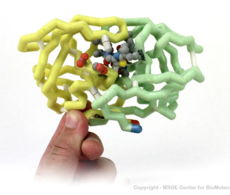Immunodeficiency virus protease
From Proteopedia
(Difference between revisions)
| (6 intermediate revisions not shown.) | |||
| Line 1: | Line 1: | ||
<StructureSection load='2nmz' size='350' side='right' background='none' scene='User:David_Canner/Sandbox_HIV/Opening/2' caption='Structure of HIV-1 Protease (PDB code [[2nmz]])'> | <StructureSection load='2nmz' size='350' side='right' background='none' scene='User:David_Canner/Sandbox_HIV/Opening/2' caption='Structure of HIV-1 Protease (PDB code [[2nmz]])'> | ||
__TOC__ | __TOC__ | ||
| - | + | ||
| - | + | ||
| - | + | ||
==Function== | ==Function== | ||
[[Human Immunodeficiency Virus]] (HIV) is the cause of Acquired Immunodeficiency Syndrome (AIDS). HIV directs the synthesis of several polyproteins, which each consist of several tandemly linked proteins. The maturation of the virus to its infectious form requires that these polyproteins be cleaved to their component proteins. <scene name='User:David_Canner/Sandbox_HIV/Opening/2'>HIV-1 protease</scene>, a homodimeric enzyme, is responsible for doing so and is therefore crucial to the virus's infectious capacity.<br /> | [[Human Immunodeficiency Virus]] (HIV) is the cause of Acquired Immunodeficiency Syndrome (AIDS). HIV directs the synthesis of several polyproteins, which each consist of several tandemly linked proteins. The maturation of the virus to its infectious form requires that these polyproteins be cleaved to their component proteins. <scene name='User:David_Canner/Sandbox_HIV/Opening/2'>HIV-1 protease</scene>, a homodimeric enzyme, is responsible for doing so and is therefore crucial to the virus's infectious capacity.<br /> | ||
| + | HIV exists in two types '''HIV-1''' and '''HIV-2'''. HIV-2 infects ca. 30% of AIDS patients vs. 70% infected by HIV-1<ref>PMID:22238126</ref>.<br /> | ||
| + | '''FIV''' is Feline Immunodeficiency virus protease.<br /> | ||
| + | '''SIV''' is Simian Immunodeficiency virus protease.<br /> | ||
| + | |||
| + | See also:[[Flaps Morph for HIV Protease]]. | ||
==Structure of HIV-1 Protease== | ==Structure of HIV-1 Protease== | ||
| Line 13: | Line 16: | ||
==Medical Implications== | ==Medical Implications== | ||
There currently is no cure or vaccine against HIV. Researchers, however, have discovered treatments that can halt and even reverse the progression of AIDS, due in large part to our understanding of the structure of HIV-1 protease. <scene name='User:David_Canner/Sandbox_HIV/Saquinavir/4'>Saquinavir</scene> ([[Invirase]]) was the first protease inhibitor approved by the FDA for the treatment of HIV. It inhibits HIV protease by <scene name='User:David_Canner/Sandbox_HIV/Saquinavir_tunnel/1'>binding tightly in the active site tunnel</scene>, preventing the binding of polyproteins. Its chemical structure mimics the tetrahedral intermediate of the hydrolytic reaction, thereby <scene name='User:David_Canner/Sandbox_HIV/Saquinavir_cat/3'>interacting strongly with the catalytic Asp residues</scene>.<ref>PMID:17243183</ref> Saquinavir is essentially an uncleavable ligand, as indicated by the <scene name='User:David_Canner/Sandbox_HIV/Hiv_morph2/9'> similar conformational changes in the protease flaps </scene> on binding saquinavir or a polypeptide. Resistance to saquinavir is due to alterations in the HIV protease sequence, including the mutation of <scene name='31/315240/Saquinavir_mut/1'>Leu 10 and Ile 50</scene><ref>PMID: 8969180</ref>. Drugs used to treat HIV infection that inhibit <scene name='User:David_Canner/Sandbox_HIV/Inhibitor_intro/1'>HIV protease</scene> include <scene name='User:David_Canner/Sandbox_HIV/Indinavir/2'>Indinavir </scene> ([[Crixivan]]), <scene name='User:David_Canner/Sandbox_HIV/Ritonavir/1'>Ritonavir</scene> ([[Norvir]]), [[Saquinavir]], [[Tipranavir]], [[Amprenavir]] (Agenerase), [[Atazanavir]] (Rayataz), [[Darunavir]] (Prezista), [[Fosamprenavir]] (Lexiva or Telzir), [[Lopinavir]] (Kaletra), [[Nelfinavir]] (Viracept) and <scene name='User:David_Canner/Sandbox_HIV/Nelfinavir/2'>Nelfinavir</scene> ([[Viracept]]). | There currently is no cure or vaccine against HIV. Researchers, however, have discovered treatments that can halt and even reverse the progression of AIDS, due in large part to our understanding of the structure of HIV-1 protease. <scene name='User:David_Canner/Sandbox_HIV/Saquinavir/4'>Saquinavir</scene> ([[Invirase]]) was the first protease inhibitor approved by the FDA for the treatment of HIV. It inhibits HIV protease by <scene name='User:David_Canner/Sandbox_HIV/Saquinavir_tunnel/1'>binding tightly in the active site tunnel</scene>, preventing the binding of polyproteins. Its chemical structure mimics the tetrahedral intermediate of the hydrolytic reaction, thereby <scene name='User:David_Canner/Sandbox_HIV/Saquinavir_cat/3'>interacting strongly with the catalytic Asp residues</scene>.<ref>PMID:17243183</ref> Saquinavir is essentially an uncleavable ligand, as indicated by the <scene name='User:David_Canner/Sandbox_HIV/Hiv_morph2/9'> similar conformational changes in the protease flaps </scene> on binding saquinavir or a polypeptide. Resistance to saquinavir is due to alterations in the HIV protease sequence, including the mutation of <scene name='31/315240/Saquinavir_mut/1'>Leu 10 and Ile 50</scene><ref>PMID: 8969180</ref>. Drugs used to treat HIV infection that inhibit <scene name='User:David_Canner/Sandbox_HIV/Inhibitor_intro/1'>HIV protease</scene> include <scene name='User:David_Canner/Sandbox_HIV/Indinavir/2'>Indinavir </scene> ([[Crixivan]]), <scene name='User:David_Canner/Sandbox_HIV/Ritonavir/1'>Ritonavir</scene> ([[Norvir]]), [[Saquinavir]], [[Tipranavir]], [[Amprenavir]] (Agenerase), [[Atazanavir]] (Rayataz), [[Darunavir]] (Prezista), [[Fosamprenavir]] (Lexiva or Telzir), [[Lopinavir]] (Kaletra), [[Nelfinavir]] (Viracept) and <scene name='User:David_Canner/Sandbox_HIV/Nelfinavir/2'>Nelfinavir</scene> ([[Viracept]]). | ||
| + | |||
| + | See also [[Treatments:HIV Protease Inhibitor Pharmacokinetics References]] | ||
== Structural Insights into the South African HIV-1 Subtype C Protease: Impact of hinge region dynamics and flap flexibility in drug resistance <ref>doi 10.1080/07391102.2012.736774</ref>== | == Structural Insights into the South African HIV-1 Subtype C Protease: Impact of hinge region dynamics and flap flexibility in drug resistance <ref>doi 10.1080/07391102.2012.736774</ref>== | ||
| Line 48: | Line 53: | ||
*[[Group:SMART:HIV-1 Subtype C Protease]] | *[[Group:SMART:HIV-1 Subtype C Protease]] | ||
*[[Human Immunodeficiency Virus]] | *[[Human Immunodeficiency Virus]] | ||
| + | *[[Ann Taylor/HIV Protease]] | ||
*[[Virus protease]] | *[[Virus protease]] | ||
*[[HIV-1 protease]] | *[[HIV-1 protease]] | ||
| Line 56: | Line 62: | ||
==Immunodeficiency virus protease 3D structures== | ==Immunodeficiency virus protease 3D structures== | ||
| - | + | [[Immunodeficiency virus protease 3D structures]] | |
==References== | ==References== | ||
| Line 62: | Line 68: | ||
</StructureSection> | </StructureSection> | ||
[[Category:Topic Page]] | [[Category:Topic Page]] | ||
| + | [[Category:3D printer files]] | ||
Current revision
| |||||||||||
Proteopedia Page Contributors and Editors (what is this?)
Joel L. Sussman, Michal Harel, Eran Hodis, Mark Hoelzer, Marius Mihasan, David Canner, Eric Martz, Ann Taylor, Wayne Decatur, Alexander Berchansky, Jaime Prilusky, Karsten Theis



